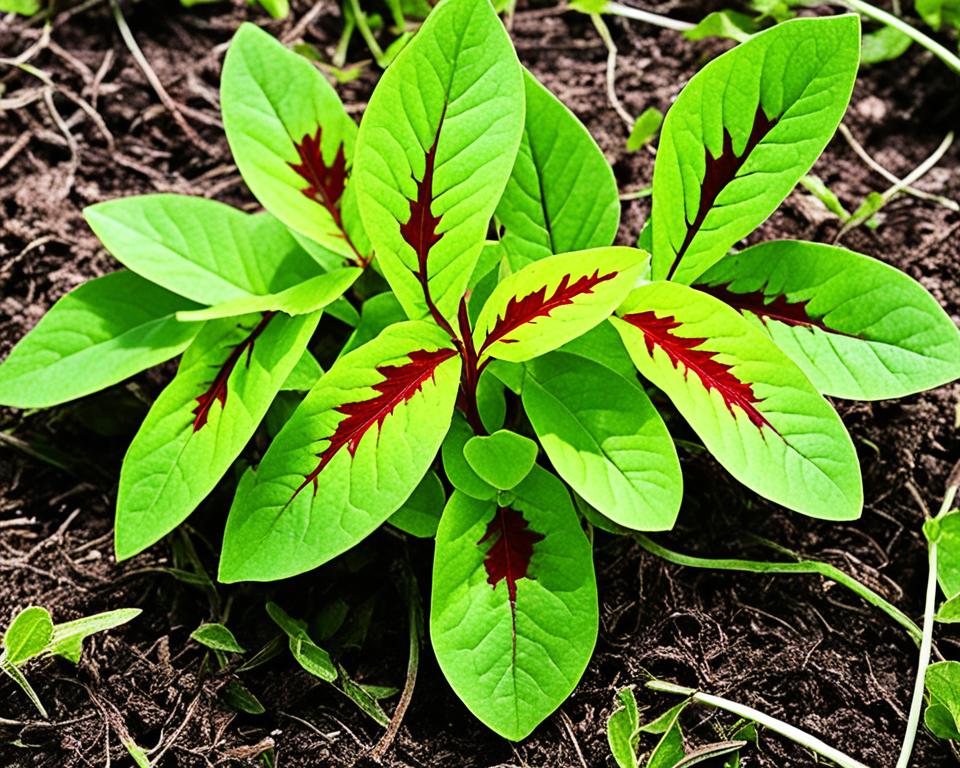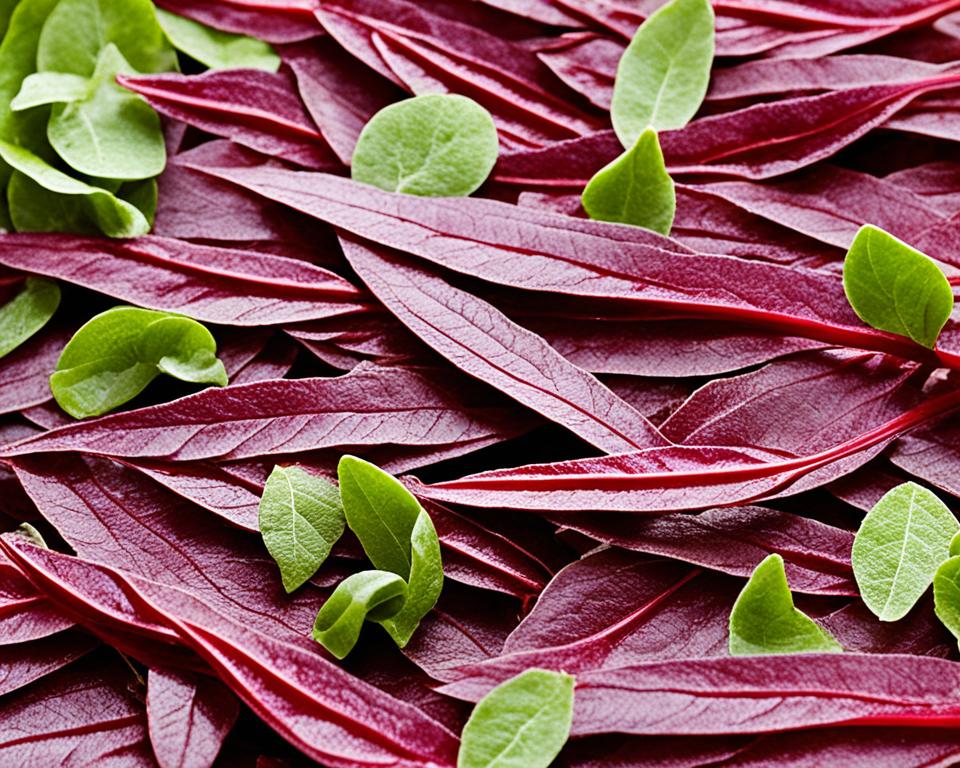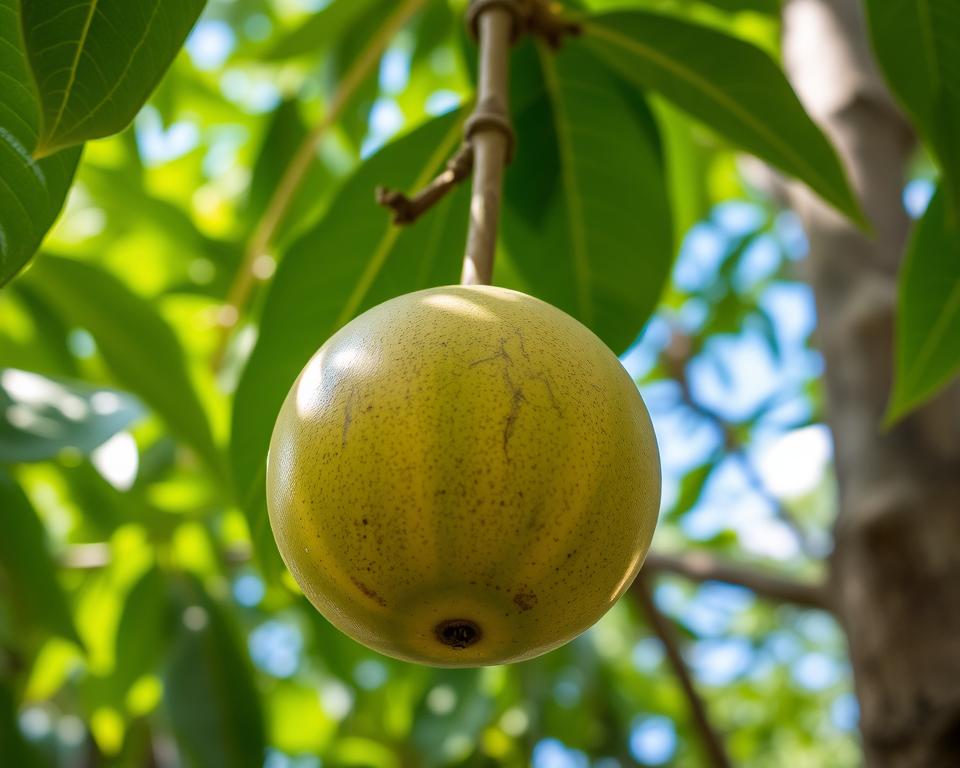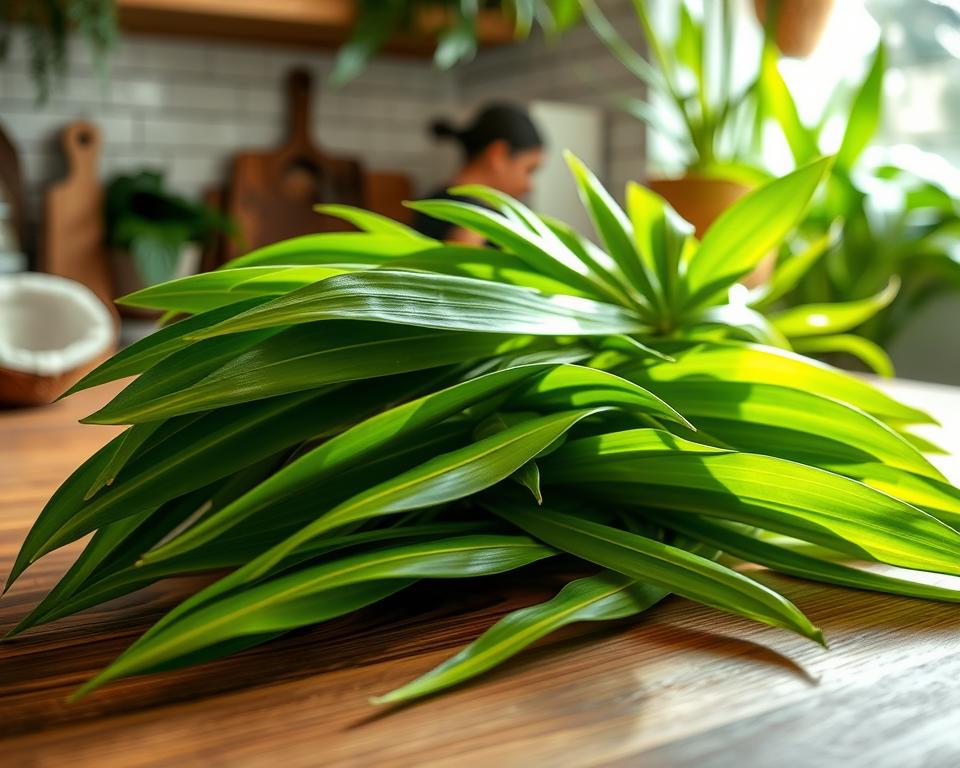Welcome to our guide on sorrel red vein, the vibrant leaf that adds a burst of color and flavor to culinary creations. This versatile herb, also known as the red sorrel plant, offers a unique twist to your dishes with its tangy taste and stunning red-veined leaves. In this article, we will explore the various uses and benefits of sorrel red vein, from enhancing the flavors of your favorite recipes to its potential health advantages.
Read interesting things at : tosawakan
Key Takeaways:
- Sorrel red vein is a vibrant leaf with red-veined leaves that is highly suitable for culinary uses.
- It adds a tangy flavor and vibrant color to an array of dishes and beverages.
- Sorrel red vein offers potential health benefits and is rich in nutrients.
- You can grow and harvest sorrel red vein at home for a fresh supply.
- There are various recipes and international cuisines that incorporate sorrel red vein.
What is Sorrel Red Vein?
In this section, we will delve into the specifics of sorrel red vein and explore its botanical characteristics and distinguishing features. Sorrel red vein, also known as the red sorrel plant, is a member of the sorrel herb family. One of the standout features of sorrel red vein is its vibrant red-veined leaves, which add a visually striking element to any garden or culinary creation.
Sorrel red vein, with its bold color and unique flavor profile, has gained popularity in the culinary world. Chefs and home cooks alike value the sorrel herb for its tangy taste and its ability to enhance the flavors of various dishes.
This versatile herb is utilized in cuisines around the world, bringing a tangy, lemony zest to soups, sauces, salads, and more. Its distinct flavor makes it a favorite among chefs seeking to add a touch of freshness and complexity to their culinary creations.
The sorrel red vein plant brings not only aesthetic appeal but also potential health benefits to the table. Rich in vitamins, minerals, and antioxidants, sorrel red vein offers a nutritional boost along with its vibrant flavor.
Next, we will explore the myriad culinary uses of sorrel red vein, showcasing the versatility of this herb in various recipes and international cuisines.
Culinary Uses of Sorrel
Sorrel red vein is not only known for its vibrant color and distinct tangy flavor, but also for its remarkable versatility in the culinary world. The edible leaves of sorrel red vein can be used in a variety of dishes and beverages, adding a unique twist to your culinary creations.
When it comes to sorrel uses, the possibilities are endless. The tangy, lemony taste of sorrel pairs well with both savory and sweet flavors, making it a versatile herb for a range of recipes.
Salads and Dressings
One popular way to incorporate sorrel red vein is by using it in salads. Its bright green leaves and tangy flavor add a refreshing element to any salad mix. Whether you toss sorrel leaves with other greens or create a salad solely based on sorrel, you can enjoy a delightful burst of flavor. It’s also a fantastic addition to dressings, providing a zesty punch that elevates the overall taste.
Soups and Stews
Sorrel red vein is often used in soups and stews to add a tangy, citrusy flavor. Its unique taste complements hearty vegetables and meats, creating a well-balanced and flavorful dish. Whether you’re making a classic French sorrel soup or incorporating sorrel into your own soup or stew recipe, it’s sure to bring a refreshing twist to the bowl.
Sauces and Condiments
The tangy flavor of sorrel red vein makes it an excellent choice for sauces and condiments. You can blend sorrel leaves into a vibrant green sauce to accompany grilled meats or fish. It also adds bright color and tanginess when used as a garnish or mixed into condiments like mayo or aioli.
Beverages
If you’re looking for a unique twist in your beverages, sorrel red vein can be a game-changer. In many countries, sorrel is used to make deliciously tart and refreshing drinks. From sorrel lemonade to hibiscus and sorrel tea, the tangy taste of sorrel adds a refreshing element to various beverages.
Whether you’re a professional chef or a home cook, incorporating sorrel red vein into your culinary repertoire can bring depth and excitement to your dishes. Experiment with different recipes and explore the diverse possibilities that sorrel offers.
| Sorrel Recipe | Description |
|---|---|
| Sorrel and Goat Cheese Tart | A savory tart that combines the tanginess of sorrel with the creaminess of goat cheese. Perfect as an appetizer or a light lunch. |
| Sorrel Pesto Pasta | A vibrant green pesto made with sorrel leaves, pine nuts, garlic, and Parmesan cheese. Toss it with your favorite pasta for a quick and flavorful meal. |
| Sorrel Lemonade | A refreshing and tangy drink made from sorrel leaves, lemon juice, and sweetened with sugar or honey. Serve it chilled on hot summer days. |
| Grilled Salmon with Sorrel Sauce | A succulent grilled salmon fillet topped with a zesty sorrel sauce, made from sorrel leaves, shallots, white wine, and cream. A perfect combination of flavors. |
Health Benefits of Sorrel Red Vein
Alongside its vibrant color and tangy flavor, sorrel red vein also offers various health benefits. This medicinal sorrel plant has been traditionally used for its therapeutic properties and is believed to possess valuable nutrients.
One notable benefit of sorrel red vein is its high content of vitamin C, an essential nutrient that supports the immune system and aids in collagen production, promoting healthy skin and tissues. Consuming sorrel red vein can contribute to overall immune health and help protect against common illnesses.
Moreover, sorrel red vein contains antioxidants, including flavonoids, which help combat oxidative stress and reduce the risk of chronic diseases. These antioxidants have been linked to improved heart health, reduced inflammation, and lower risk of certain cancers.
This red-veined sorrel also possesses diuretic properties, meaning it promotes urine production and can aid in detoxification. This can help cleanse the body and support kidney health.
“Sorrel red vein is a versatile herb that not only adds flavor to dishes but also provides potential health benefits.”
Furthermore, some studies suggest that sorrel red vein may have antimicrobial properties, making it effective against certain types of bacteria. While more research is needed to fully understand its potential in this area, incorporating sorrel red vein into your diet may contribute to a healthy microbial balance in the body.
It is important to note that, like any herb or supplement, sorrel red vein should be consumed in moderation and as part of a balanced diet. If you have any underlying health conditions or are taking medications, it is advisable to consult a healthcare professional before incorporating sorrel red vein into your routine.
With its combination of vibrant color, tangy flavor, and potential health benefits, sorrel red vein is a valuable addition to any culinary repertoire.
Growing and Harvesting Sorrel Red Vein
When it comes to cultivating and harvesting sorrel red vein, proper knowledge and techniques can ensure a successful and bountiful harvest. By understanding the preferred growing conditions and implementing the right planting and maintenance practices, you can enjoy a continuous supply of this vibrant herb.
Growing Conditions
- Sunlight: Sorrel red vein thrives in full sun to partial shade, making it suitable for various garden setups. Aim for at least six hours of direct sunlight per day.
- Soil: This herb prefers moist, well-drained soil with a slightly acidic to neutral pH level. Ensure good drainage to prevent waterlogging.
- Watering: Keep the soil consistently moist, but avoid overwatering, as this can lead to root rot. Regular watering during dry spells is recommended.
- Temperature and Hardiness: Sorrel red vein is hardy to USDA zones 4-9 and can withstand cooler temperatures. Provide protection during extreme heat or frost.
Planting Techniques
When planting sorrel red vein, follow these steps for optimal growth:
- Prepare the soil by removing any weeds or debris and loosening it with a garden fork or spade.
- Sow the seeds or transplant the seedlings into the prepared soil, ensuring a spacing of 12-18 inches between plants.
- Lightly cover the seeds or root ball with soil, then water gently to settle the soil around the plants.
Maintenance Tips
To maintain healthy sorrel red vein plants, consider the following tips:
- Fertilization: Apply a balanced organic fertilizer to provide essential nutrients. Follow the manufacturer’s instructions for proper application.
- Weeding: Regularly remove weeds around your sorrel red vein plants to minimize competition for nutrients and water.
- Pruning: Prune off any damaged or yellowing leaves to promote new growth and maintain overall plant health.
Harvesting and Preserving
The ideal time to harvest sorrel red vein is when the leaves are young and tender, usually around 6-8 weeks after planting. Gently cut the outer leaves, leaving the center intact for continued growth. Freshly harvested sorrel red vein can be used immediately, or you can preserve its freshness by refrigerating it in a plastic bag or freezing it for later use.
To freeze sorrel red vein, blanch the leaves in boiling water for a few seconds, then transfer them to an ice bath. Once cooled, drain and pat dry the leaves before placing them in a freezer-safe container or bag. Frozen sorrel red vein can be stored for up to six months.
| Growing Conditions | Planting Techniques | Maintenance Tips |
|---|---|---|
| Full sun to partial shade | Prepare soil, sow seeds/transplant seedlings | Apply organic fertilizer, remove weeds, prune damaged leaves |
| Moist, well-drained soil | Spacing: 12-18 inches | |
| Slightly acidic to neutral pH | Cover seeds/root ball with soil | |
| Consistently moist soil | Water gently after planting | |
| Hardy to USDA zones 4-9 |
Sorrel Red Vein Recipes
Get ready to tantalize your taste buds with these delicious recipes featuring sorrel red vein as a star ingredient. The vibrant, edible sorrel leaves add a tangy and refreshing twist to these culinary creations, showcasing the versatility of sorrel red vein in various dishes.
1. Sorrel Red Vein Salad
Enjoy a burst of flavors with this refreshing sorrel red vein salad. Combine fresh sorrel leaves with crisp greens, cherry tomatoes, and a zesty citrus dressing for a vibrant and nutritious dish. The sorrel leaves lend a unique sour note, balancing the sweetness of the tomatoes.
2. Sorrel Red Vein Soup
Warm up with a comforting bowl of sorrel red vein soup. Saute onions, garlic, and potato, then simmer them with vegetable broth and sorrel leaves. Blend the mixture until smooth and garnish with a dollop of sour cream for a velvety and tangy soup that will leave you wanting more.
3. Sorrel Red Vein Pesto
Elevate your pasta dishes with a twist by making sorrel red vein pesto. In a food processor, blend fresh sorrel leaves, garlic, pine nuts, Parmesan cheese, and olive oil until smooth. Toss the pesto with your favorite pasta for a vibrant, flavorful, and easy-to-make dish.
4. Sorrel Red Vein Lemonade
Beat the heat with a refreshing glass of sorrel red vein lemonade. Steep sorrel leaves in boiling water, strain the liquid, and mix it with freshly squeezed lemon juice, honey, and ice. Sip on this tangy and revitalizing drink that combines the flavors of sorrel and citrus.
5. Sorrel Red Vein Tart
Create a show-stopping dessert with a sorrel red vein tart. Prepare a buttery tart crust and fill it with a silky smooth filling made from sorrel leaves, eggs, sugar, and cream. Bake until the tart is golden brown and serve it chilled for a delightful combination of sweetness and tartness.
These mouthwatering recipes demonstrate the versatility of sorrel red vein and the incredible flavors it brings to your table. Don’t miss out on the opportunity to explore the unique culinary possibilities offered by this vibrant and delicious herb.
Sorrel Red Vein in Traditional Medicine
In addition to its culinary uses, sorrel red vein has a rich history of being utilized in traditional medicine. This vibrant herb, known botanically as Rumex acetosa, possesses potential therapeutic properties that have been recognized for centuries.
Throughout various cultures, the medicinal sorrel plant has been employed to address a range of health concerns. Its leaves have traditionally been infused in teas, tinctures, and poultices to harness its potential health benefits. The popularity of sorrel red vein in traditional medicine stems from its unique composition of vitamins, minerals, and bioactive compounds.
“Sorrel red vein possesses several medicinal properties that have been scientifically studied and observed in traditional practices.”
Sorrel red vein is rich in vitamin C, which contributes to its potential immune-boosting properties and antioxidant effects. It is also a source of other essential vitamins and minerals, such as vitamin A, potassium, and magnesium, which are beneficial for overall health and well-being.
One of the key sorrel benefits is its potential as a natural diuretic, aiding in the elimination of excess fluids from the body. The plant’s high oxalic acid content is believed to contribute to this diuretic effect.
Furthermore, early research suggests that sorrel red vein may possess anti-inflammatory and antimicrobial properties. These properties make it potentially useful for alleviating inflammatory conditions and supporting the body’s defense against harmful microorganisms.
The Medicinal Applications of Sorrel Red Vein
In traditional medicine, sorrel red vein has been used to address various ailments. Some of the specific applications include:
- Relief from digestive issues
- Support for liver function
- Boosting cardiovascular health
- Alleviating respiratory conditions
It is important to note that while sorrel red vein has a long-standing history in traditional medicine, more scientific research is needed to fully understand and validate its potential therapeutic properties.

As with any herbal remedy, it is recommended to consult with a healthcare professional before using sorrel red vein for medicinal purposes, especially if you are taking any medications or have underlying health conditions.
While sorrel red vein offers exciting potential as a natural remedy, it is essential to remember that traditional uses and scientific evidence should be viewed as complementary. Understanding the medicinal sorrel plant from both perspectives allows for a holistic approach to incorporating this versatile herb into one’s wellness routine.
Cultivating Sorrel Red Vein at Home
If you’re a culinary enthusiast or a lover of fresh, vibrant flavors, growing sorrel red vein in your own garden is a rewarding experience. This versatile herb adds a tangy punch to dishes and brings a pop of color to any plate. In this section, we’ll guide you through the process of cultivating sorrel red vein at home, from container gardening options to essential care tips.
Container Gardening for Sorrel Red Vein
One of the easiest ways to grow sorrel red vein is through container gardening. This method allows you to cultivate this herb even if you have limited outdoor space. Choose a well-draining container with a depth of at least 10 inches to provide ample room for the root system to develop.
Fill the container with a high-quality potting mix, enriched with organic matter. Sorrel red vein thrives in slightly acidic soil with a pH level between 6.0 and 6.5. Ensure that the container has drainage holes to prevent waterlogging, which can lead to root rot.
Essential Care for Sorrel Red Vein
Sorrel red vein requires consistent moisture to thrive. Water the plant regularly, keeping the soil evenly moist. However, avoid overwatering, as excessive moisture can cause fungal diseases. Aim to keep the soil slightly damp but not waterlogged.
Position your sorrel red vein plant in a location that receives partial shade to full sun. This herb prefers temperatures between 60°F and 70°F (15°C to 21°C) and can tolerate light frosts. If the climate is too hot, provide shade during the hottest part of the day to prevent the plant from wilting.
Fertilize your sorrel red vein plant every four to six weeks during the growing season. Use a balanced organic fertilizer to provide essential nutrients for healthy growth. Follow the manufacturer’s instructions for application rates.
Harvesting Sorrel Red Vein
Sorrel red vein is ready for harvest when the leaves reach a size of about 6 inches (15 cm) in length. Harvest the outer leaves by cutting them off at the base using clean scissors or pruning shears. Leave the center leaves untouched to allow for continued growth.
Regular harvesting encourages the production of new leaves and prolongs the plant’s lifespan. Remember, sorrel red vein leaves are best enjoyed when fresh, so harvest only what you need for immediate use.
Summary
By following these tips for cultivating sorrel red vein at home, you can enjoy the benefits of this flavorful herb in your own kitchen. Whether you’re growing sorrel red vein in a container or in your garden, providing the right growing conditions and care will ensure a bountiful harvest of tangy, vibrant leaves. Get started on your sorrel red vein gardening adventure and elevate your culinary creations with its unique flavor.
| Cultivating Sorrel Red Vein at Home |
|---|
| Choose a well-draining container |
| Use quality potting mix |
| Keep soil moist, but avoid overwatering |
| Position in partial shade to full sun |
| Fertilize every 4-6 weeks |
| Harvest outer leaves when 6 inches in length |
Storage and Preservation of Sorrel Red Vein
When it comes to sorrel red vein, preserving its vibrant flavor and color is essential to ensure its culinary excellence throughout the year. To help you extend the shelf life of your sorrel red vein harvest, we’ve compiled a few tried-and-tested methods of storage and preservation.
Refrigeration
One of the simplest ways to store sorrel red vein is by refrigerating it. Begin by trimming any wilted or discolored leaves, then gently wash and dry the remaining leaves. Next, place the sorrel red vein leaves in a sealed plastic bag or an airtight container lined with paper towels to absorb excess moisture. Store the container in the refrigerator’s crisper drawer for up to a week. Remember to check the leaves periodically and discard any that show signs of spoilage.
Freezing
Freezing is another effective method of preserving sorrel red vein for an extended period. Start by blanching the leaves in boiling water for a minute, then transfer them to an ice bath to stop the cooking process. Drain and thoroughly dry the blanched sorrel red vein leaves before placing them in airtight freezer bags or containers. Be sure to remove as much air as possible from the bags to prevent freezer burn. Label the bags with the date and store them in the freezer for up to six months. Frozen sorrel red vein works best when used in cooked dishes or sauces.
Drying
Drying sorrel red vein is an excellent way to preserve its bright flavor and unique characteristics. Begin by tying small bunches of sorrel red vein upside down in a well-ventilated area away from direct sunlight. Allow the leaves to dry completely until they become crumbly. Once dried, gently remove the leaves from the stems and store them in airtight containers away from heat and light. Dried sorrel red vein can be used in teas, spice blends, or crumbled into dishes to add a tangy kick.
“Proper storage and preservation methods help maintain the vibrant flavor and color of sorrel red vein, allowing you to enjoy its culinary benefits all-year-round.”
Now that you’re equipped with these storage and preservation techniques, you can savor the distinct taste of sorrel red vein long after its harvest season. Whether you choose to refrigerate, freeze, or dry your sorrel red vein, following these methods will ensure that you have a supply of this vibrant herb readily available whenever your culinary creations call for it.
Sorrel Red Vein in International Cuisines
Sorrel red vein, with its vibrant color and tangy flavor, has become a popular ingredient in various international cuisines. Its unique taste adds a refreshing twist to traditional dishes, making it a favorite among chefs and home cooks alike.
In French cuisine, sorrel red vein is often used in soups and sauces. Its bright green leaves add visual appeal to dishes like sorrel soup, while its tangy flavor provides a pleasant contrast to creamy sauces.
“Sorrel red vein brings a delightful tartness to classic French dishes, balancing the richness of creamy soups and enhancing the flavors of delicate sauces.” – Chef Marie Durand
In Jamaican cuisine, sorrel red vein is a key ingredient in the popular Jamaican sorrel drink. Made by steeping the leaves in hot water and adding spices and sweeteners, this refreshing beverage is enjoyed during festive occasions and holidays.
Other international cuisines also incorporate sorrel red vein in their recipes. In African cuisine, it is used to flavor stews and salads, adding a zingy taste to hearty dishes. In Caribbean cuisine, sorrel red vein is often seen in seafood recipes, providing a burst of flavor and color to dishes like grilled fish.
Whether it’s in a French soup, a Jamaican drink, or an African stew, sorrel red vein adds a vibrant touch to international cuisines, elevating the taste and visual appeal of dishes.

Key Takeaways:
- Sorrel red vein is used in various international cuisines for its vibrant color and tangy flavor.
- In French cuisine, it’s used in soups and sauces to balance richness and enhance flavors.
- In Jamaican cuisine, sorrel red vein is a key ingredient in the popular Jamaican sorrel drink.
- It is also utilized in African and Caribbean cuisines to add zingy taste and vibrant color to dishes.
Sorrel Red Vein Varieties
When it comes to sorrel red vein, there are several varieties to explore, each with its own unique characteristics. One such variety is red-veined sorrel, known for its stunning red veins that run through its vibrant green leaves.
Red-veined sorrel not only adds a pop of color to dishes but also imparts a tangy flavor that elevates culinary creations. Its distinct appearance makes it a visually appealing ingredient in salads, soups, and sauces, while its bright acidity adds a refreshing twist to various dishes.
While red-veined sorrel is a popular variety, it’s worth noting that there are other types of sorrel red vein available as well. These variations may differ in terms of flavor intensity, leaf size, and overall appearance. Some varieties may have narrower or broader red veins, providing an additional visual element to dishes.
Whether you’re using red-veined sorrel or exploring other sorrel red vein varieties, these vibrant leaves offer a delightful culinary experience. Their tangy taste and striking appearance make them a versatile ingredient that can enhance a wide range of dishes.
The Culinary Versatility of Sorrel Red Vein
Sorrel red vein is a truly remarkable herb that offers an abundance of culinary possibilities. Its vibrant leaves and tangy flavor make it a versatile ingredient that can elevate the taste of various dishes and beverages.
From Soups and Sauces to Salads and Cocktails
Whether you’re looking to add a zing to your soups, create a flavorful sauce, or spruce up your salads and cocktails, sorrel red vein is the perfect companion. Its vibrant color adds visual appeal to your creations, while its sharp, lemony taste adds a delightful twist to every bite or sip.
“Sorrel red vein brings a unique and refreshing touch to my salad dressings, enhancing the flavors of the ingredients and adding a pop of color to every bowl.” – Chef Emily Roberts
In salads, sorrel red vein can be used as a standalone green or mixed with other leafy vegetables to add a burst of flavor. Its bright acidity complements the richness of dressings and balances the sweetness of fruits, creating a harmonious blend of tastes on your plate.
When it comes to soups and sauces, sorrel red vein adds depth and complexity. Its tangy notes cut through the richness of creamy soups, giving them a refreshing finish. As a key ingredient in sauces, sorrel red vein livens up the flavors, turning a simple dish into an exceptional culinary experience.
Unleash Your Creativity
With sorrel red vein, the possibilities are truly endless. Let your imagination run wild and experiment with different dishes and preparations. From sorrel-infused cocktails to sorrel-filled dumplings, this herb allows you to explore new flavor combinations and surprise your taste buds.
Whether you’re a professional chef or a passionate home cook, sorrel red vein is an ingredient that will add a touch of excitement to your culinary creations. Its versatility, vibrant color, and distinctive flavor make it a must-have herb in any kitchen.
Conclusion
In conclusion, sorrel red vein is a vibrant and versatile herb that offers numerous culinary possibilities. Its striking red-veined leaves add a visually appealing touch to various dishes and beverages, while its tangy flavor provides a unique and refreshing taste. As we have seen throughout this article, sorrel red vein not only enhances the overall sensory experience of meals but also brings potential health benefits to the table.
Whether incorporated into soups, salads, sauces, or cocktails, sorrel red vein can elevate the taste profile of any recipe. Its presence can enliven the flavors and add a touch of sophistication to both traditional and international cuisines. Moreover, the nutritional value of sorrel red vein makes it a worthwhile addition to one’s diet, offering vitamins, minerals, and potential medicinal properties.
As you explore the world of sorrel red vein, consider the various ways it can enhance your culinary creations. From growing and harvesting your own plants at home to experimenting with tantalizing recipes, there are endless possibilities for incorporating sorrel red vein into your dishes. Embrace the vibrancy, flavor, and health benefits of this remarkable herb, and let it take your culinary journey to new heights.










